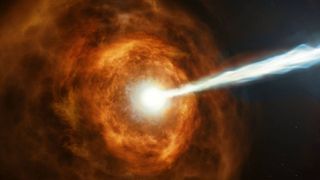Astronomers just spotted the most powerful flash of light ever seen
The gamma-ray burst was also the nearest ever detected.

Astronomers just detected what may be the most powerful flash of light ever seen.
The so-called gamma-ray burst, the most energetic type of electromagnetic explosion known to exist in the universe, was first spotted by telescopes Sunday (Oct. 9).
Gamma-ray bursts, which were discovered accidentally by U.S. military satellites in the 1960s, are likely produced when giant stars explode at the ends of their lives before collapsing into black holes, or when ultradense stellar remnants known as neutron stars collide. Within seconds, these explosions unleash as much energy as the sun will emit during its entire 10-billion-year lifetime.
The flash detected Sunday was the strongest one ever observed, releasing 18 teraelectronvolts of energy. Scientists are still analyzing the measurements, but if the findings are confirmed, the gamma-ray burst would be the first gamma-ray burst ever found to carry more than 10 teraelectronvolts of energy.
Related: Gamma-ray bursts might be much rarer than we thought, study suggests
At first, the strength of the flash confused astronomers; they thought it must have been produced by a relatively close source. They also initially believed that the energy was coming in X-rays, rather than in gamma-rays. Subsequent analyses of the signal confirmed that it was indeed a gamma-ray burst coming from a source some 2.4 billion light-years away. While not exactly nearby, the gamma-ray burst is still the closest ever seen.
Although this gamma-ray burst was within a safe distance from Earth, a much closer one would be catastrophic to our planet. Such an energetic flash within thousands of light-years from Earth would strip the planet of its protective ozone layer and likely cause mass extinction. In fact, scientists think one of the biggest mass-extinction events in Earth's history — the Ordovician extinction, which occurred 450 million years ago — may have been triggered by such a blast, according to NASA.
Get the Space.com Newsletter
Breaking space news, the latest updates on rocket launches, skywatching events and more!
Although the recently spotted gamma-ray burst, dubbed GRB221009A, appeared 20 times closer to Earth than an average gamma-ray burst, it is still far enough away to cause more excitement than concern.
"This is indeed a very exciting event!" Gemma Anderson, an astronomer at Curtin University in Australia, who studies similar phenomena, told ScienceAlert. "This event being so nearby but also very energetic means the radio, optical, X-ray and gamma-ray light it produces is extremely bright and therefore easy to observe. We can therefore study this gamma ray burst with lots of big and small telescopes around the world and collect very comprehensive datasets as it first brightens and then fades away."
Gamma-ray bursts come in two varieties. Short gamma-ray bursts are rarer and last no longer than two seconds. These bursts make up about 30% of all such events and are believed to be caused by collisions of neutron stars. The other type, long gamma-ray bursts, can last up to several minutes and are likely produced by hypernovas, stellar explosions that are 100 times brighter than supernovas, in which supermassive stars die after running out of the hydrogen fuel in their cores.
Astronomers mostly see the afterglow of these explosions that comes from electrons energized by the blast. GRB221009A appears to be a long gamma-ray burst, but astronomers don't know yet what gave rise to it.
"It is still too early to tell," Anderson told ScienceAlert. "The light from an underlying supernova will take days to brighten. However, given this gamma-ray burst's long duration, it may be a very powerful type of supernova."
Telescopes all over the world (and in Earth's orbit) are now pointing at the dusty galaxy from which the flash emerged. They will try to observe the light generated by the explosion in as many wavelengths as possible to get the most complete picture of its origin.
"When you are dealing with cosmic explosions that blast out stellar remains at near the speed of light, leaving a black hole behind, you are watching physics occurring in the most extreme environments that are impossible to recreate on Earth," Anderson told ScienceAlert. "We still don't fully understand this process. Such a nearby explosion means we can collect very high quality data to study and understand how such explosions occur."
The observations were first published in the Astronomer's Telegram on Sunday, Oct. 9.
Follow Tereza Pultarova on Twitter @TerezaPultarova. Follow us on Twitter @Spacedotcom and on Facebook.
Join our Space Forums to keep talking space on the latest missions, night sky and more! And if you have a news tip, correction or comment, let us know at: community@space.com.

Tereza is a London-based science and technology journalist, aspiring fiction writer and amateur gymnast. Originally from Prague, the Czech Republic, she spent the first seven years of her career working as a reporter, script-writer and presenter for various TV programmes of the Czech Public Service Television. She later took a career break to pursue further education and added a Master's in Science from the International Space University, France, to her Bachelor's in Journalism and Master's in Cultural Anthropology from Prague's Charles University. She worked as a reporter at the Engineering and Technology magazine, freelanced for a range of publications including Live Science, Space.com, Professional Engineering, Via Satellite and Space News and served as a maternity cover science editor at the European Space Agency.
